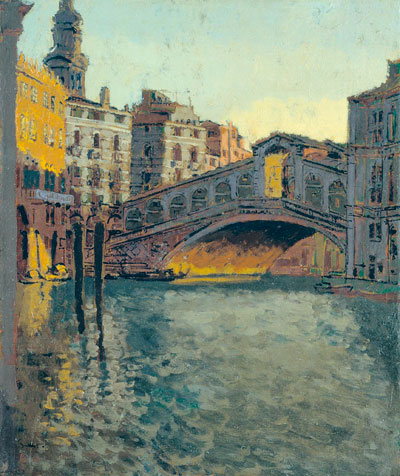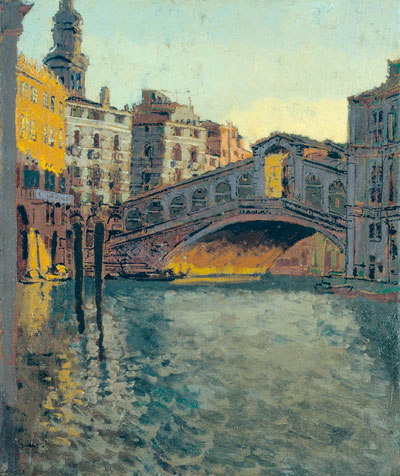Walter Sickert at Dulwich Picture Gallery
Matthew Sturgis steps into the magical world of rain-soaked La Serenissima through the theatrical and influential paintings of Walter Sickert


Venice is the most theatrical city in the world. It looks like a stage set. For several weeks of the year during Carnevale everyone appears to be in costume. And, at other times, an air of drama pervades even the most mundane exchanges of Venetian life. It is no surprise that Walter Sickert, who had made his youthful reputation as painter-in-ordinary of the London Music Hall, should have been excited by the place. He visited the city to paint several times, from 1895 to 1903. It proved a rich seam. With characteristic hyperbole, he described it as his ‘gold mine’.
At Dulwich Picture Gallery, ‘Sickert in Venice’ brings together a selection of choice nuggets, works made in the city over the best part of a decade. It was a decisive decade in Sickert’s development and, it is not too much to say, in the development of British art. As so often in the tide of human history, the motive force of change was the weather.
By and large, the weather in Venice is clement. And Sickert’s earliest Venetian paintings were Impressionistic views of the great sights of the city: the façade of St Mark’s, La Salute, the Rialto Bridge. Long intrigued by the play of gaslight on dusty theatre mirrors, he eagerly took up the challenge of recording the effects of late-afternoon sunshine reflected in the waters of the lagoon.

The paintings proved popular, at least in comparison to his other works. He had several successful exhibitions in Paris. In England, he showed his new Venetian pictures at the Fine Art Society, the gallery on Bond Street that he praised as ‘the best shop in London’. (The gallery is still on Bond Street and still showing Sickert’s work: an exhibition of his etchings ‘Walter Sickert as Printmaker’ opens today and runs until March 27.)
And then the rains came. The Italian winter of 1903 was exceptionally wet. Torrential down- pours disrupted Sickert’s plans for sketching in the piazza. He acquired a pair of cork-soled boots to keep his feet dry, but even these proved to be inadequate as water levels rose. Unable to work outside, Sickert began sketching the denizens of his favourite trattoria, the Giorgione. And, soon, he was inviting these models back to his little studio-room.
The local prostitutes proved the most rewarding subjects. He posed them nude or clothed, perched on his bed or on the sofa. He became fascinated by the sense of drama suggested by their juxtapositions. It was a theme that opened up a whole new world to him, one that he continued to explore throughout his long subs-equent career. It reinvigorated his painting, and in time his example reinvigorated the whole figurative tradition of British painting. And it began in the rain in Venice.
‘Sickert in Venice’ is at Dul-wich Picture Gallery, Gallery Road, London SE21 until May 31 (020–8693 5254; www.dulwichpicturegallery.org.uk)
Sign up for the Country Life Newsletter
Exquisite houses, the beauty of Nature, and how to get the most from your life, straight to your inbox.
Country Life is unlike any other magazine: the only glossy weekly on the newsstand and the only magazine that has been guest-edited by HRH The King not once, but twice. It is a celebration of modern rural life and all its diverse joys and pleasures — that was first published in Queen Victoria's Diamond Jubilee year. Our eclectic mixture of witty and informative content — from the most up-to-date property news and commentary and a coveted glimpse inside some of the UK's best houses and gardens, to gardening, the arts and interior design, written by experts in their field — still cannot be found in print or online, anywhere else.
-
 Vertigo at Victoria Falls, a sunset surrounded by lions and swimming in the Nile: A journey from Cape Town to Cairo
Vertigo at Victoria Falls, a sunset surrounded by lions and swimming in the Nile: A journey from Cape Town to CairoWhy do we travel and who inspires us to do so? Chris Wallace went in search of answers on his own epic journey the length of Africa.
By Christopher Wallace
-
 A gorgeous Scottish cottage with contemporary interiors on the bonny banks of the River Tay
A gorgeous Scottish cottage with contemporary interiors on the bonny banks of the River TayCarnliath on the edge of Strathtay is a delightful family home set in sensational scenery.
By James Fisher